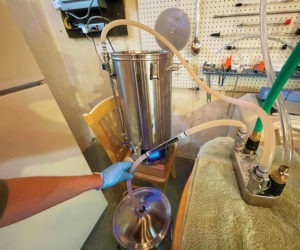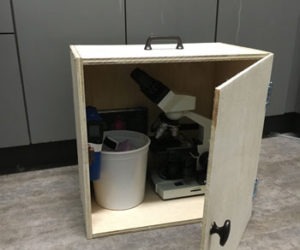Build the Ultimate Equipment Rack: Projects

My first beer was a wheat beer that I brewed on the kitchen stove. I brewed my next 25 or so batches on the stove as well. Later, I purchased a propane burner and moved from the kitchen to the back porch. Both of these brewing situations had one thing in common. Whatever I needed — hose, spoon, valve, filtered water, racking tube — was always downstairs above the large laundry room cleanup sink. On most brew days I climbed so many flights of stairs that I didn’t need to go to the gym.
Now that I am planning a new indoor brew house, creating a central repository for every bit of brewing paraphernalia — the Ultimate Equipment Rack — became a must-do. So I sat with pencil and paper, sketching what a great rack system should encompass.
For glass objects — like Erlenmeyer flasks, graduates, testtubes and bottles — a regular laboratory drying rack would be great. Long hosesneed to hang high enough so their ends don’t touch the floor or counter, and other odd bits — like spoons, clamps, quick disconnects, wire and filters — would best have individual hooks. For these items, a pegboard needs be incorporated. Large vessels — like gallon-sized yeast starter bottles — should have a shelf, one that permits rapid air drying when wet. An ordinary coated wire laundry or kitchen shelf will work well and is inexpensive. So here is our wish-list of items: a pegboard, a wire shelf and a laboratory drying rack. Some of these items can simply be purchased at the home improvement store, while others will have to be built.
There is a fundamental problem with building the Ultimate Equipment Rack. While the wire shelves are relatively impervious to water, any wood other than marine-grade plywood is likely to swell and disintegrate. This is particularly true of the pressed paper pegboard and the easy-to-work medium density fiberboard (MDF) used for our lab drying rack. Sealing the surfaces and painting or varnishing is absolutely imperative (unless you’ve invented a water-free brewing system). Of course, you can buy water-resistant pegboards, but then you don’t get the fun of building a board that’s custom-designed for your own brewing gear.
Parts list
2’ x 4’ white pegboard $4.50
4’ wire shelf $9.00
3/4” dowels (3), 1/2” dowels (4) $5.50
sanding sealer $9.00
paint $8.00
The tools you need
Most of our materials can be purchased precut or cut to size at the store. What remains — cutting dowels and battens — can be accomplished with a hand saw or saber saw, and a drill. For mounting the complete system you might need a masonry drill bit and anchors.
Step by step
Will you follow my dimensions? Not unless your brewhouse is identical to mine. But the dimensions will be similar and construction should proceed along the same lines. Take a look at what I’ve done and modify all the dimensions given to fit your own brewing storage situation.
Laboratory drying rack
A lab drying rack is simply an assembly of wooden dowels stuck into a wooden sheet at an angle. The angle should be consistent and is typically 60°. The rack hangs so the dowels point upward at an angle. Glassware can be placed upside-down on the pegs and any water inside the container will run out as it dries.
Start by selecting the correct size of 3/4” MDF or plywood. Both are easy to drill, but both need extensive sealing. I used MDF as it drills and works the easiest. I don’t have a commercial drill press with a 24” throat and angled table, so I had to use a hand drill. But how could I drill at the correct angle? Actually, it was simple. I traced a 60° angle onto a spare cardboard box and cut it to size. That gave me a 60° slope long enough to rest my drill against.
1. Cut your MDF or plywood (marine- grade preferred) to 36” x 42”.
2. With a framing square, mark several lines across the board and mark positions for insertions of wooden dowels. I made six rows.
3. Mark locations for dowels. Dowels should be made of hard wood and cut to 6” lengths. When locating dowels, stagger each succeeding row. Staggering allows yourself room to place larger flasks or bottles on the rack. For my rack, I marked off places for five dowels of the top row, four dowels on the row below it and then back to five. On the fourth row, it switches to having seven smaller pegs.
4. Drill appropriately-sized holes using your homemade angle guide. I used 3/4” dowels for the top three rows and 1/2” dowels for the lower three rows.
5. Glue or use silicon seal to secure all dowels in their holes.
6. Seal with sanding sealer. Two coats are better than one. Scuff with steel wool, green scrubbers, or sandpaper between coats.
7. Give all surfaces a final scuff, then paint or varnish. Use a high-gloss paint or varnish to seal the surface.
Pegboard
Pegboard is made of pressed, adhesive-impregnated paper. Moisture quickly makes it delaminate and each hole provides plenty of additional vulnerable surfaces. You must seal those surfaces exposed by drilling with a penetrating sealer.
Pegboard is available in precut sizes, including 4’ x 8’, 4’ x 4’, and 2’ x 4’. If you have a choice, purchase 3/8” thick pegboard for its strength. But beware, most pegboard hooks are meant for 1/4” thick pegboard.
1. Cut a 2’ x 4’ section of thick pegboard to 24” x 42”.
2. Cut several 3/4” x 1-1/2” x 42” battens to add stiffness and enough standoff so your hooks will insert easily.
3. Scuff the finish of every surface and seal generously with sanding sealer.
4. Glue and screw the battens to the back of your pegboard
in an “H” or rectangle. Use stainless steel screws (#8 x 3/4”).
5. Apply a second or third coat of sealer. Dry, scuff and paint.
Wire shelving
Wire shelving is available in several widths and lengths and may be cut to size. They have the welcome attribute of providing open drain space and plenty of weight-holding capacity.
Shelving is available in packaged units that include hangers, end caps and supports. The supplied fasteners are meant for wooden studs and dry wall, but will work in cement if you drill a hole. This requires the use of a special carbide-tipped drill.
Final assembly
Attach your drying rack and pegboard to the wall using appropriate fasteners. In my case that will be two- inch galvanized or stainless steel deck screws. My brewhouse, now under construction, has studded walls.
Decide on an appropriate height for your shelf, perhaps allowing enough room for glass fermenters. If you’ll be putting fermenters on your shelf you’ll want one that’s 18” deep and “pantry” rated. And for luck add an extra support and hanger.


